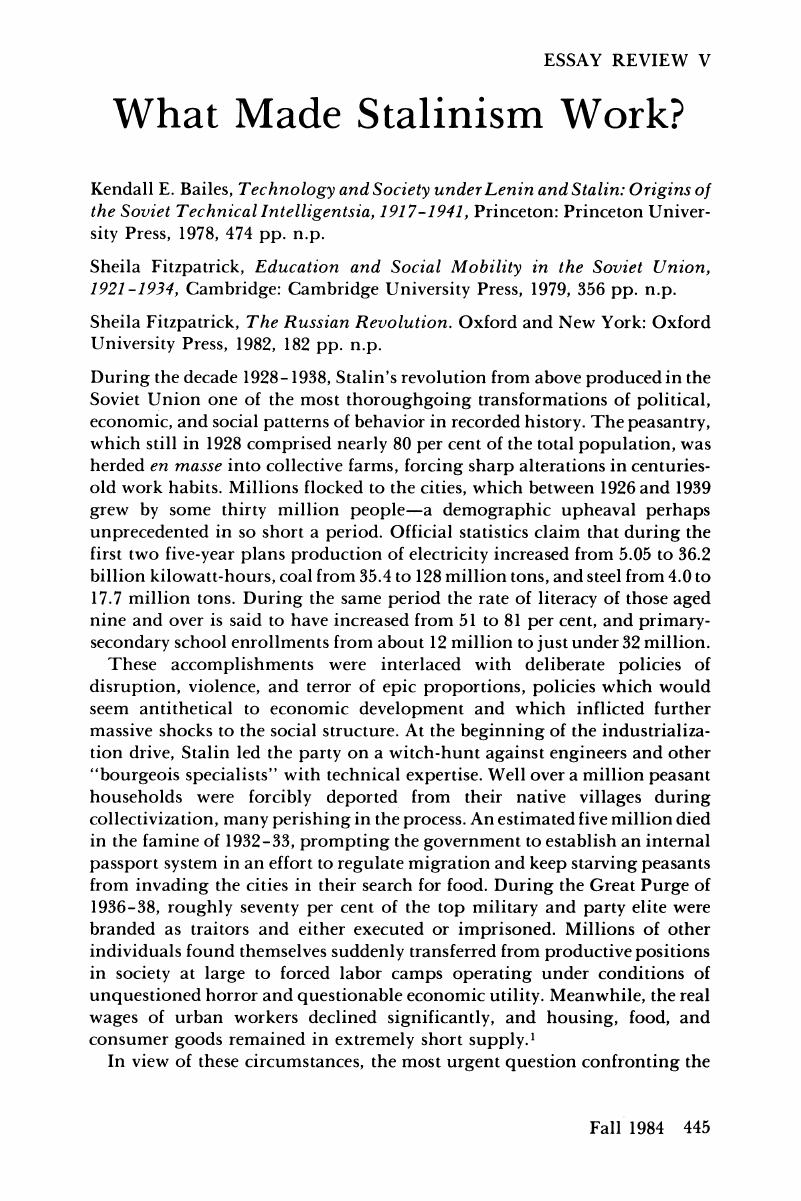No CrossRef data available.
Published online by Cambridge University Press: 24 February 2017

1. For an analysis which interprets Stalinism as a political culture and stresses its revolutionary aspects, see Tucker, Robert C., “Stalinism as Revolution from Above,” in Tucker, Robert C. (ed.), Stalinism: Essays in Historical Interpretation (New York, 1977), pp. 77–108. Figures on urban growth and peasant deportations are from Lewin, Moshe, “Society, State, and Ideology during the First Five-Year Plan,” in Fitzpatrick, Sheila (ed.), Cultural Revolution in Russia, 1928–1931 (Bloomington & London, 1978), pp. 41–77, which captures extremely well the social chaos and fluidity of the period. Solzhenitsyn's Gulag Archipelago forthrightly challenges Soviet economic statistics, a position that is developed by Steven Rosefielde in “The First ‘Great Leap Forward’ Reconsidered: Lessons of Solzhenitsyn's Gulag Archipelago,” Slavic Review, 39, no. 4 (December 1980):559–87, and is criticized in the ensuing debate:588–615.Google Scholar
2. The best Soviet secondary works on higher education during this period are Ukraintsev, V. V., KPSS—Organizator revoliutsionnogo preobrazovaniia vysshei shkoly (Moscow, 1963), and Chanbarisov, Sh. Kh., Formirovanie sovetskoi universitetskoi sistemy (1917–1938 gg.) (Ufa, 1973).Google Scholar
3. Bailes, , Technology and Society under Lenin and Stalin, p. 6; Fitzpatrick, Sheila, “Stalin and the Making of a New Elite, 1928–1939,” Slavic Review, 38, no. 3 (September 1979):400. Andropov graduated from a secondary technical school in 1936. Chernenko is the first general secretary since Stalin with no technical education.Google Scholar
4. This idea is presented in Fitzpatrick, , Education and Social Mobility, developed further in “Stalin and the Making of a New Elite,” and given a broader context in her The Russian Revolution. Moshe Lewin views the upwardly mobile of the thirties in rather different terms. He stresses their brutality to those below them and servility to those above and regards them as primarily of peasant rather than proletarian origin and outlook. Lewin, Moshe, “The Social Background of Stalinism,” in Tucker, (ed.), Stalinism, pp. 111–36. See also (though it deals with the later postwar period) Dunham, Vera, In Stalin's Time: Middleclass Values in Soviet Fiction (Cambridge, 1976).Google Scholar
5. Lipset, Seymour H. and Bendix, Reinhard, Social Mobility in Industrial Society (Berkeley and Los Angeles, 1959). See pp. 11–75 for the first point, and pp. 76–113 for the second.Google Scholar
6. Boudon, Raymond, Education, Opportunity, and Social Inequality: Changing Prospects in Western Society (New York, 1974); Jencks, Christopher, et al., Inequality: A Reassessment of the Effect of Family and Schooling in America (New York, 1972).Google Scholar
7. Ringer, Fritz K., Education and Society in Modern Europe (Bloomington & London, 1979), pp. 104–12, 261–62.Google Scholar
8. One important step in that direction is Jarausch, Konrad (ed.), The Transformation of Higher Learning, 1860–1930 (Stuttgart & Chicago, 1983).Google Scholar
9. McClelland, James C., “Proletarianizing the Student Body: The Soviet Experience during the New Economic Policy,” Past & Present, No. 80 (August 1978):122–46.Google Scholar